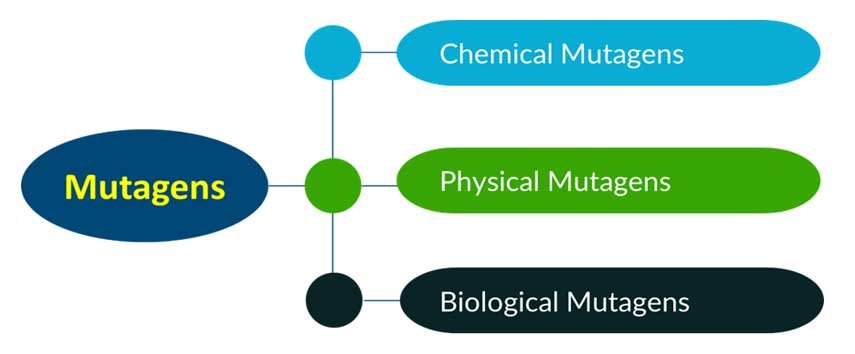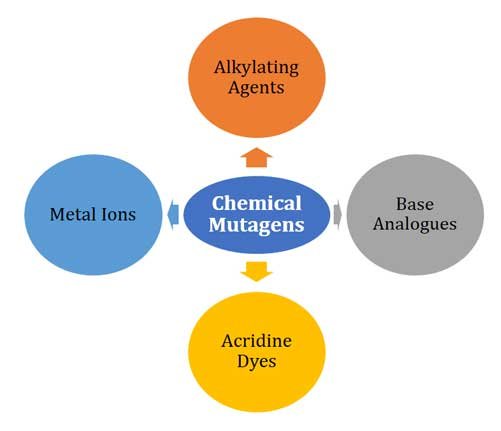Mutagen is any agent that causes genetic mutations, which are changes in an organism’s DNA sequence. Mutations can occur naturally or as a result of exposure to various mutagens such as chemicals, radiation, and viruses. Mutations can have a variety of effects on an organism. Understanding mutagens and their effects on genetic material is critical in fields such as genetics, plant breeding, and cancer research. The present post discusses what are mutagens and What are the different categories of mutagens such as Physical and Chemical Mutagens.
Learning objective: What are mutagens? Classification of Mutagens, Physical and Chemical Mutagens, Biological mutagens.
What are Mutagens?
Ø Agents with cause mutation in the organism are called mutagens.
Ø There are different classes of mutagens based on their chemical or physical properties.
Ø All these mutagens induce mutations in the genome by the structural or chemical modification of the genetic material (DNA).
Mutagens are Classified into two Broad Categories:
Learn more: Mutation Breeding
- Chemical mutagens
- Physical mutagens
- Biological mutagens

Chemical mutagens
Ø Chemical molecules which induce mutations are called chemical mutagens.
Ø Different class chemical mutagens are
(a). Base analogues
(b). Alkylating agents
(c). Acridine dyes
(d). Metal ions

Base analogues
Ø Example: 5-bromo uracil, amino purine, 5-chloro uracil, Nitrous acid, hydroxy amine, sodium asides.
Ø Base analogues have structural similarities to the bases i.e., purines and pyrimidines.
Ø Aminopurine is a structural analogue to adenine and can form a base pair with C or T.
Ø 5-Bromouracil exhibits tautomeric forms. Keto form of the 5-bromouracil replaces thymine in the DNA and forms a pair with the adenine in the DNA
Ø Enol forms of 5-bromouracil complementary base pair with guanine
Ø 5-Bromo uracil thus cause point mutation.
Learn more: Nucleotide Biosynthesis
Alkylating agents
Ø Example: Sulphur mustard, nitrogen mustard, epoxides, Ethyl-methane sulphonate (EMS), Methyl methane sulphonate (MMS), nitroso compound (Eg. N-methyl-N-nitro-N-guanidine-MNNG)
Ø Alkylating agents induce alkyl groups in DNA resulting in DNA damage.
Ø The introduction of the alkyl groups increases ionization that results in base-pairing errors and eventually inducing gaps in the DNA strand.
Acridine dyes
Ø Example: Proflavine, Acridine orange, Acridine yellow, Ethidium bromide.
Ø They are DNA intercalating agents that have a hydrophobic heterocyclic ring structure and resemble the ring structure of base pairs
Ø These agents intercalate into the DNA helix, which eventually interferes with the replication, translation, and transcription resulting in mutation.
Metal ions
Ø Example: Nickel, chromium, cobalt, cadmium, arsenic, chromium, and iron
Ø These metal ions generate reactive oxygen species (ROS) that cause DNA hypermethylation.
| You may also like NOTES in... | ||
|---|---|---|
| BOTANY | BIOCHEMISTRY | MOL. BIOLOGY |
| ZOOLOGY | MICROBIOLOGY | BIOSTATISTICS |
| ECOLOGY | IMMUNOLOGY | BIOTECHNOLOGY |
| GENETICS | EMBRYOLOGY | PHYSIOLOGY |
| EVOLUTION | BIOPHYSICS | BIOINFORMATICS |
Physical mutagens
Ø Physical mutagens are physical agents that cause mutation.
Ø The most important physical mutagens are radiations.
Ø They are different types of radiations which are categorized into two categories.
(a). Ionizing Radiations
(b). Non-ionizing Radiations
Ionizing radiations
Ø They include particulate radiations (α-rays, β-rays and fast neutrons) and non-particulate radiations (X-rays andγ-rays).
Ø Ionising radiation can directly damage the DNA molecule by breaking the bonds that hold the nucleotides together as it passes through cells.
Ø Single-strand breaks, double-strand breaks, and other types of damage can occur in one or both strands of DNA.
Learn more: DNA Repair Mechanism
Ø Ionising radiation’s most dangerous effect on DNA is the induction of double-strand breaks, which are more difficult for cells to repair and can result in mutations and chromosomal abnormalities.
Ø These mutations can cause cancer if they occur in critical genes that control cell division.
Non-ionizing radiation
Ø This include Ultraviolet (UV) radiation.
Ø UV radiation can cause DNA damage, primarily through the formation of photoproducts.
Ø UV radiation is classified as UVA (320-400 nm), UVB (280-320 nm), and UVC (100-280 nm) based on its wavelength.
Ø UVC is highly energetic and is largely absorbed by the ozone layer in the atmosphere, whereas UVA and UVB account for the majority of UV radiation reaching the earth’s surface.
Learn more: Photoreactivation DNA Repair
Ø UV radiation can cause the formation of pyrimidine dimers, which are covalent bonds between adjacent thymine or cytosine bases, when it is absorbed by DNA.
Ø These dimers have the potential to disrupt DNA replication and transcription, resulting in mutations, chromosomal abnormalities, and cell death.
Ø UVB radiation is the most effective at generating pyrimidine dimers.
Biological Mutagenic Agents
Ø Biological mutagenic agents includes:
(a). Viruses
(b). Bacteria
(c). Transposons

Virus
Ø Viruses can induce mutations in their host cells by inserting their DNA into the host genome and this can disrupt the normal function of DNA or genes.
Ø Example: Rous sarcoma virus have been reported to induce cancer by mutating host genome.
Bacteria
Ø Certain inflammation-inducing bacteria like Helicobacter pylori produces reactive oxygen species (ROS).
Ø ROS cause severe DNA damage and reduced DNA repair.
Learn more: Microbiolog Notes
Transposons and Insertion Sequence (IS)
Ø They are DNA units that perform self-directed DNA fragment relocation and multiplication
Ø Insertion sequences (IS) are of 10 to 50 base pairs long are the simplest type of transposons.
Ø Both IS and transposon are referred to as jumping genes because they move from one position to another position on the genome.
Ø The introduction of transposons into chromosomal DNA disrupts gene function.
Ø IS and transposons both encode information for the enzyme transposases, which aid in the creation of new transposition locations in the DNA.
Ø Transposons are typically classified into three types:
Ø Replicative transposons: Transposons that keep the original locus and move its copy.
Ø Conservative transposons: The original transposon translocates itself in these transposons.
Ø Retrotransposons transpose: These transposons move through RNA intermediates.
Summary
Mutagens are substances that cause mutations, resulting in changes in an organism’s genetic material. Mutagens are classified into three types: chemical, physical, and biological mutagens. Chemical mutagens such as base analogues, alkylating agents and DNA intercalating agents can change DNA by modifying or damaging nucleotides. Ionising radiation, such as X-rays and gamma rays, and ultraviolet radiation from the sun are examples of physical mutagens that can break DNA strands or cause errors during DNA replication.
Viruses and transposons are examples of biological mutagens because they can insert themselves into the genome and cause changes in gene expression or function. Understanding the various types of mutagens and their effects on DNA is critical for identifying potential environmental or occupational hazards and devising mitigation strategies.
<<< Back to PLANT BREEDING Notes
| You may also like... | ||
|---|---|---|
| NOTES | QUESTION BANK | COMPETITIVE EXAMS. |
| PPTs | UNIVERSITY EXAMS | DIFFERENCE BETWEEN.. |
| MCQs | PLUS ONE BIOLOGY | NEWS & JOBS |
| MOCK TESTS | PLUS TWO BIOLOGY | PRACTICAL |
Dear readers
Hope this article helped you to understand What are Mutagens and Different Types of Mutagens. I would like to take this opportunity to request your COMMENTS on the topics I have covered. Whether you have a suggestion, a question about the topic, or simply want to share your thoughts, I would love to hear from you. So, please do not hesitate to leave a comment below. I appreciate your support and look forward to hearing from you.
Best regards, [Admin, EasyBiologyClass]
